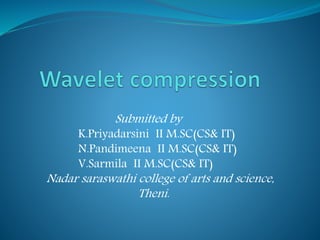wavelet compression
- 1. Submitted by K.Priyadarsini II M.SC(CS& IT) N.Pandimeena II M.SC(CS& IT) V.Sarmila II M.SC(CS& IT) Nadar saraswathi college of arts and science, Theni.
- 2. wavelet compression ? Wavelet compression is a form of data compression well suited for image compression (sometimes also video compression and audio compression). ? Notable implementations are JPEG2000 , Divu and ECW for still images, Cine Form, and the BBC's Dirac. ? The goal is to store image data in as little space as possible in a file. ? Wavelet compression can be either lossless or lossy. ? Using a wavelet transform, the wavelet compression methods are adequate for representing transients. ? such as percussion sounds in audio, or high-frequency components in two-dimensional images, for example an image of stars on a night sky.
- 3. Method ? First a wavelet transform is applied. ? This produces as many coefficients as there are pixels in the image (i.e., there is no compression yet since it is only a transform). ? These coefficients can then be compressed more easily because the information is statistically concentrated in just a few coefficients. ? This principle is called transform coding. ? After that, the coefficients are quantized and the quantized values are entropy encoded and/or run length encoded.
- 5. The Idea ? The idea is to start first with a gray scale image, and do like you would proceed for a PNG image compressor: pick your buffer and group the pixels in tiles of 2x2. ? Now, if you only store the average color of the four pixels of each tile you are already compressing by 1:4. Good. Of course the image resolution has decreased. ? Let's fix it by storing the real value of the 4 pixels in a compact manner. ? Because these pixels are physically near to each other, we can pretty safely assume their colors will be similar to that average color that we already encoded. ? So, instead of storing these pixels as full gray scale values, let's store only the amount by which they are different to the average color
- 6. The Details ? Well, not quite. Wavelets are a complex signal processing tool, and what we are doing here is nothing but scratching the very surface of the thing. ? In fact, what we are doing is to use one of the many possible Wavelets basis, the Haar wavelet to be more precise. ? But we are not going into filter-banks and dsp stuff here - instead we just will see how I implemented this simple multilevel color encoding technique and how I had my image compressed into my demo.
- 7. Color Images ? So far we have compressed gray scale images only. ? For color images we are gonna use a very standard method that makes storing color very unexpensive, almost for free. ? The naive approach of decomposing the rgb images in three independent gray scale images is a very bad idea, you should NEVER do that. Instead we are going to use the popular luma/chroma decomposition, as JPG does.








